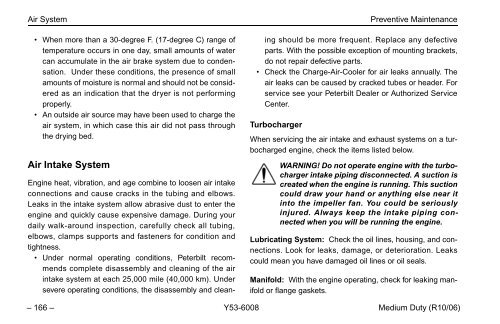Peterbilt Medium Duty Trucks Operator's Manual after 1-07
Peterbilt Medium Duty Trucks Operator's Manual after 1-07
Peterbilt Medium Duty Trucks Operator's Manual after 1-07
You also want an ePaper? Increase the reach of your titles
YUMPU automatically turns print PDFs into web optimized ePapers that Google loves.
Air System<br />
• When more than a 30-degree F. (17-degree C) range of<br />
temperature occurs in one day, small amounts of water<br />
can accumulate in the air brake system due to condensation.<br />
Under these conditions, the presence of small<br />
amounts of moisture is normal and should not be considered<br />
as an indication that the dryer is not performing<br />
properly.<br />
• An outside air source may have been used to charge the<br />
air system, in which case this air did not pass through<br />
the drying bed.<br />
Air Intake System<br />
Preventive Maintenance<br />
Engine heat, vibration, and age combine to loosen air intake<br />
connections and cause cracks in the tubing and elbows.<br />
Leaks in the intake system allow abrasive dust to enter the<br />
engine and quickly cause expensive damage. During your<br />
daily walk-around inspection, carefully check all tubing,<br />
elbows, clamps supports and fasteners for condition and<br />
tightness.<br />
• Under normal operating conditions, <strong>Peterbilt</strong> recommends<br />
complete disassembly and cleaning of the air<br />
intake system at each 25,000 mile (40,000 km). Under<br />
severe operating conditions, the disassembly and cleaning<br />
should be more frequent. Replace any defective<br />
parts. With the possible exception of mounting brackets,<br />
do not repair defective parts.<br />
• Check the Charge-Air-Cooler for air leaks annually. The<br />
air leaks can be caused by cracked tubes or header. For<br />
service see your <strong>Peterbilt</strong> Dealer or Authorized Service<br />
Center.<br />
Turbocharger<br />
When servicing the air intake and exhaust systems on a turbocharged<br />
engine, check the items listed below.<br />
WARNING! Do not operate engine with the turbocharger<br />
intake piping disconnected. A suction is<br />
created when the engine is running. This suction<br />
could draw your hand or anything else near it<br />
into the impeller fan. You could be seriously<br />
injured. Always keep the intake piping connected<br />
when you will be running the engine.<br />
Lubricating System: Check the oil lines, housing, and connections.<br />
Look for leaks, damage, or deterioration. Leaks<br />
could mean you have damaged oil lines or oil seals.<br />
Manifold: With the engine operating, check for leaking manifold<br />
or flange gaskets.<br />
– 166 – Y53-6008 <strong>Medium</strong> <strong>Duty</strong> (R10/06)
















